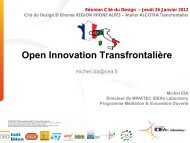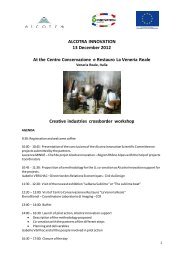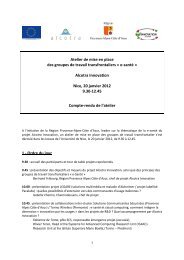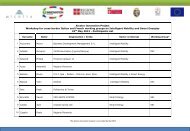Best practices Database for Living Labs - ALCOTRA - Innovation
Best practices Database for Living Labs - ALCOTRA - Innovation
Best practices Database for Living Labs - ALCOTRA - Innovation
Create successful ePaper yourself
Turn your PDF publications into a flip-book with our unique Google optimized e-Paper software.
13.1 User Involvement<br />
User involvement is one of the key elements of a <strong>Living</strong> Lab, and as such should be a focal point of mature<br />
<strong>Living</strong> <strong>Labs</strong>. In creating usable systems it is generally accepted that they should be designed according to<br />
an iterative approach, and that user involvement is crucial. The focus is on finding out what the relevant<br />
experiences, methods, tools that <strong>Living</strong> <strong>Labs</strong> benefit from are. Users are important to define context-aware<br />
services, think <strong>for</strong> example of cultural differences. Organizational issues include questions like How to<br />
organize user involvement? How to find the right users? What about the validity? How to motivate the<br />
users? From a technological point of view: How to get access to large user groups? How to analyse large<br />
amounts of data? Analyzing social context data, application usage data and user experience data collected<br />
in real-life settings presents new challenges - it’s not clear a priori which data is relevant. There<strong>for</strong>e, new<br />
analysis and reporting modules might be needed along with scalable, flexible storage and computing<br />
resources to cope with large amount.<br />
13.2 Service Creation<br />
Service creation with relevance to the <strong>Living</strong> <strong>Labs</strong> describes the value added components that <strong>Living</strong> <strong>Labs</strong><br />
can bring to innovation and validation. ‘Value-added’ implies we are ‘bringing something new and needed<br />
to the table’. Historically, the development of <strong>Living</strong> <strong>Labs</strong> has been stimulated by the cross-regional need to<br />
improve innovation and competitiveness. Service creation within ENoLL should have pan-European<br />
relevance as opposed to that national or regional relevance. The resultant objectives of such an<br />
environment provide us with three underlying categories of required services [5]: services supporting<br />
collaborative innovation, services supporting validation and demonstration, and services specific to<br />
stakeholder requirements. On a more operational level of <strong>Living</strong> <strong>Labs</strong> and ENoLL, three types of horizontal<br />
services structure the service matrix: technical services – communication, collaboration, demonstration,<br />
prototyping, validation, product deployment etc., customer services – innovation, idea generation,<br />
community services, training, specific service needs, business support, market customization, and thirdly,<br />
intra-network services (within ENoLL) – governance, management and training.<br />
13.3 Infrastructure<br />
Within this context, a simple definition of infrastructure can be given as the basic facilities, services, and<br />
installations, or underlying framework or features required <strong>for</strong> the operation of a <strong>Living</strong> Lab. In order to<br />
harmonize the infrastructures used and/or developed in the different <strong>Living</strong> <strong>Labs</strong>, infrastructures can be<br />
categorized by their use during the entire life cycle of the <strong>Living</strong> Lab. The first set of criteria determines<br />
which infrastructures are chosen to be used at the establishment of the <strong>Living</strong> Lab. Infrastructures will be<br />
chosen depending on the environment in which the <strong>Living</strong> Lab is to be deployed and the objectives which<br />
are to be achieved. The second category includes criteria defining which infrastructures are candidates to<br />
achieve the <strong>Living</strong> <strong>Labs</strong>’ self-sustainability. The key ones in each <strong>Living</strong> Lab will be shared within the<br />
network. The third set of criteria will determine infrastructures are more apt to evolve and adapt than<br />
others. These are the ones that will be considered with a higher level of scalability.<br />
The organizational perspective describes the infrastructures used in each <strong>Living</strong> Lab with the purpose of<br />
supporting the organization of the <strong>Living</strong> Lab. The contextual perspective describes the infrastructures used<br />
in each <strong>Living</strong> Lab in the context of the <strong>Living</strong> Lab. Finally; the technological perspective describes the<br />
infrastructures used in each <strong>Living</strong> Lab as the technology backbone of the <strong>Living</strong> Lab.<br />
The project is co-funded by the ERDF<br />
Page 68 of 78









